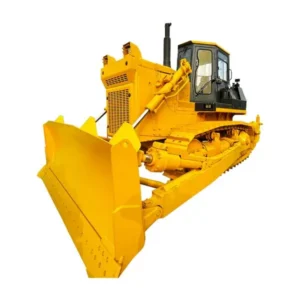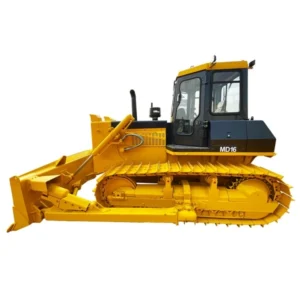Introducción
Bulldozers are essential heavy equipment in construction, mining, and various other industries. They are designed to push large quantities of soil, sand, rubble, or other materials. Given their versatility and power, understanding the different types of bulldozers is crucial for selecting the right one for your project. This guide will provide a comprehensive overview of the types of bulldozers, their features, and their best use cases. By the end of this article, you’ll have a clear understanding of which bulldozer type will best meet your project requirements.
Understanding the Basics: What is a Bulldozer?

A bulldozer is a powerful tracked or wheeled vehicle equipped with a substantial metal blade used to push large quantities of material. Bulldozers are commonly used in construction, mining, agriculture, and heavy industry. They come in various sizes and configurations, each tailored for specific tasks and environments.
Key Components of a Bulldozer
- Cuchilla: The large, heavy plate at the front of the bulldozer used for pushing material.
- Tracks or Wheels: Provide mobility and traction. Tracked bulldozers are more common and offer better stability on rough terrain.
- Destripador: A claw-like device at the back used for breaking up hard ground or asphalt.
- Cab: The operator’s compartment, which is usually enclosed for safety and comfort.
Table: Basic Specifications of Bulldozers
| Componente | Descripción |
|---|---|
| Cuchilla | Metal plate for pushing materials |
| Tracks/Wheels | Provides mobility and traction |
| Destripador | Breaks up hard ground or asphalt |
| Cab | Operator’s compartment, often enclosed |
Types of Bulldozers
There are several types of bulldozers, each designed for specific tasks and conditions. Understanding these types will help you choose the right bulldozer for your project.
Crawler Bulldozer
Crawler bulldozers, also known as track bulldozers, are the most common type. They run on tracks, providing excellent traction and stability on rough terrain. Crawler bulldozers are ideal for heavy-duty tasks such as land clearing, grading, and excavation.
Features:
- Excellent stability on uneven terrain
- High traction on soft or muddy ground
- Suitable for heavy-duty tasks
Best Use Cases:
- Construction sites
- Mining operations
- Land clearing and grading
Wheel Bulldozer
Wheel bulldozers, also known as tire bulldozers, are equipped with large, heavy-duty tires instead of tracks. They offer better mobility and speed compared to crawler bulldozers and are suitable for tasks that require frequent movement over hard surfaces.
Features:
- Greater speed and mobility
- Suitable for hard, flat surfaces
- Easier to transport
Best Use Cases:
- Road construction
- Urban construction projects
- paisajismo
Table: Comparison of Crawler and Wheel Bulldozers
| Feature | Crawler Bulldozer | Wheel Bulldozer |
|---|---|---|
| Mobility | Lower, due to tracks | Higher, due to wheels |
| Traction | Excellent on soft ground | Better on hard, flat surfaces |
| Speed | Slower | Faster |
| Transportabilidad | More challenging to transport | Easier to transport |
| Best Use Cases | Heavy-duty tasks, uneven terrain | Urban projects, road construction |
Mini Bulldozer
Mini bulldozers, also known as compact bulldozers, are smaller versions of crawler or wheel bulldozers. They are designed for tasks in confined spaces where larger machines cannot operate efficiently.
Features:
- Compact size for tight spaces
- Versatile and maneuverable
- Suitable for light to medium-duty tasks
Best Use Cases:
- Residential construction
- paisajismo
- Small-scale demolition
Swamp Bulldozer
Swamp bulldozers are specially designed to operate in marshy, swampy, or muddy areas. They are equipped with wider tracks or pontoons to distribute weight more evenly and prevent sinking.
Features:
- Wide tracks or pontoons for better weight distribution
- High flotation on soft, wet ground
- Designed for swampy or marshy conditions
Best Use Cases:
- Wetland construction
- Dredging operations
- Marshland restoration
Hybrid Bulldozer
Hybrid bulldozers combine the features of crawler and wheel bulldozers. They offer the traction and stability of tracks with the mobility and speed of wheels, making them versatile for various applications.
Features:
- Combination of tracks and wheels
- Versatile for different terrains
- Efficient fuel consumption
Best Use Cases:
- Mixed-terrain projects
- Long-distance material pushing
- Energy-efficient operations
Table: Summary of Bulldozer Types and Use Cases
| Bulldozer Type | Key Features | Best Use Cases |
|---|---|---|
| Crawler Bulldozer | Tracks, high traction, stability | Construction, mining, land clearing |
| Wheel Bulldozer | Tires, greater speed, mobility | Road construction, urban projects |
| Mini Bulldozer | Compact size, maneuverability | Residential construction, landscaping |
| Swamp Bulldozer | Wide tracks/pontoons, high flotation | Wetland construction, dredging |
| Hybrid Bulldozer | Tracks and wheels, versatile, fuel-efficient | Mixed-terrain projects, energy-efficient operations |
Choosing the Right Bulldozer for Your Project
Selecting the right bulldozer involves understanding your project’s specific requirements, including the type of terrain, the nature of the tasks, and the project scale. Here are some factors to consider:
Terrain and Ground Conditions
- Soft or Muddy Ground: Opt for a crawler or swamp bulldozer to ensure better traction and stability.
- Hard, Flat Surfaces: Wheel bulldozers offer better mobility and speed on hard, flat terrain.
- Confined Spaces: Mini bulldozers are ideal for projects in tight or restricted areas.
Nature of the Tasks
- Heavy-Duty Tasks: Crawler bulldozers are suitable for heavy-duty tasks such as excavation, grading, and land clearing.
- Frequent Movement: Wheel bulldozers are better for tasks that require frequent relocation over hard surfaces.
- Special Conditions: Swamp bulldozers are designed for operations in swampy or marshy areas.
Project Scale
- Large-Scale Projects: Full-sized crawler or wheel bulldozers are suitable for extensive construction or mining projects.
- Small-Scale Projects: Mini bulldozers are perfect for smaller projects such as residential construction or landscaping.
Consideraciones presupuestarias
- Cost of Purchase or Rental: Determine your budget and consider the cost of purchasing or renting the bulldozer.
- Maintenance Costs: Factor in the maintenance costs associated with the bulldozer type.
- Operational Efficiency: Evaluate the fuel efficiency and operational costs of the bulldozer.
Table: Factors to Consider When Choosing a Bulldozer
| Factor | Considerations |
|---|---|
| Terrain and Ground Conditions | Type of terrain, stability requirements |
| Nature of the Tasks | Heavy-duty vs. light-duty tasks, movement frequency |
| Project Scale | Size and scope of the project |
| Consideraciones presupuestarias | Purchase/rental cost, maintenance, operational efficiency |
Advantages and Disadvantages of Different Types of Bulldozers
Understanding the advantages and disadvantages of each type of bulldozer will help you make an informed decision for your project.
Crawler Bulldozer
Advantages:
- High traction and stability on rough terrain
- Ideal for heavy-duty tasks
- Durable and robust design
Disadvantages:
- Lower mobility and speed
- More challenging to transport
- Higher operating costs due to track maintenance
Wheel Bulldozer
Advantages:
- Greater speed and mobility
- Easier to transport
- Suitable for hard, flat surfaces
Disadvantages:
- Less traction on soft ground
- Not ideal for heavy-duty tasks
- Limited stability on uneven terrain
Mini Bulldozer
Advantages:
- Compact size for confined spaces
- Versatile and maneuverable
- Lower operating costs
Disadvantages:
- Limited power for heavy-duty tasks
- Not suitable for large-scale projects
- May lack advanced features of larger bulldozers
Swamp Bulldozer
Advantages:
- High flotation on soft, wet ground
- Designed for swampy or marshy conditions
- Prevents sinking and provides stability
Disadvantages:
- Limited use on hard surfaces
- Specialized design may limit versatility
- Higher cost due to specialized features
Hybrid Bulldozer
Advantages:
- Combines features of crawler and wheel bulldozers
- Versatile for different terrains
- Efficient fuel consumption
Disadvantages:
- Higher cost due to advanced features
- More complex maintenance requirements
- May not excel in highly specialized tasks
Table: Advantages and Disadvantages of Bulldozer Types
| Bulldozer Type | Advantages | Disadvantages |
|---|---|---|
| Crawler Bulldozer | High traction, stability, heavy-duty tasks | Lower mobility, challenging to transport |
| Wheel Bulldozer | Speed, mobility, easy transport | Less traction, limited stability |
| Mini Bulldozer | Compact, versatile, lower operating costs | Limited power, not for large-scale projects |
| Swamp Bulldozer | High |
flotation, stability in wet conditions | Limited use on hard surfaces |
| Hybrid Bulldozer | Versatile, efficient, mixed-terrain use | Higher cost, complex maintenance |
Future Trends in Bulldozer Technology

The construction and heavy equipment industry is continuously evolving, and bulldozers are no exception. Here are some future trends in bulldozer technology:
Automation and Remote Operation
Advancements in automation technology are making it possible to operate bulldozers remotely. This not only enhances safety by reducing the need for operators in hazardous environments but also increases efficiency by allowing for more precise control.
Electric and Hybrid Bulldozers
With the push towards sustainability, manufacturers are developing electric and hybrid bulldozers. These machines reduce emissions and operational costs, making them environmentally friendly alternatives to traditional diesel-powered bulldozers.
Advanced Monitoring and Control Systems
Modern bulldozers are being equipped with advanced monitoring and control systems that provide real-time data on performance, fuel consumption, and maintenance needs. These systems help operators optimize performance and reduce downtime.
Funciones de seguridad mejoradas
Safety is a top priority in the construction industry, and new bulldozer models are being designed with enhanced safety features such as improved visibility, automatic shutdown systems, and collision avoidance technology.
Table: Future Trends in Bulldozer Technology
| Trend | Descripción |
|---|---|
| Automation and Remote Operation | Remote control for enhanced safety and precision |
| Electric and Hybrid Bulldozers | Reduced emissions, lower operational costs |
| Advanced Monitoring Systems | Real-time performance data, optimized operations |
| Funciones de seguridad mejoradas | Improved visibility, automatic shutdown, collision avoidance |
Conclusion: Types of Bulldozers
Selecting the right excavadora for your project involves understanding the different types of bulldozers, their features, and their best use cases. Whether you need the stability of a crawler bulldozer, the mobility of a wheel bulldozer, the compactness of a mini bulldozer, the specialized design of a swamp bulldozer, or the versatility of a hybrid bulldozer, there is a machine tailored to meet your specific requirements. By considering factors such as terrain, task nature, project scale, and budget, you can make an informed decision that will enhance the efficiency and success of your project.
Preguntas Frecuentes
What is the primary difference between crawler and wheel bulldozers?
Crawler bulldozers run on tracks, providing excellent stability and traction on rough terrain, making them ideal for heavy-duty tasks. Wheel bulldozers, on the other hand, are equipped with tires, offering greater mobility and speed on hard, flat surfaces.
When should I use a mini bulldozer?
Mini bulldozers are best suited for projects in confined spaces where larger machines cannot operate efficiently. They are ideal for residential construction, landscaping, and small-scale demolition tasks.
What makes swamp bulldozers unique?
Swamp bulldozers are designed with wider tracks or pontoons to distribute weight more evenly, preventing sinking and providing stability on soft, wet ground. They are ideal for operations in marshy or swampy conditions.
Are hybrid bulldozers cost-effective?
Hybrid bulldozers combine the features of crawler and wheel bulldozers, offering versatility for different terrains and efficient fuel consumption. While they may have a higher upfront cost, their operational efficiency and versatility can make them cost-effective in the long run.
What future trends are expected in bulldozer technology?
Future trends in bulldozer technology include automation and remote operation, electric and hybrid models, advanced monitoring and control systems, and enhanced safety features. These advancements aim to improve efficiency, reduce emissions, and enhance operator safety.








-150x150.webp)
